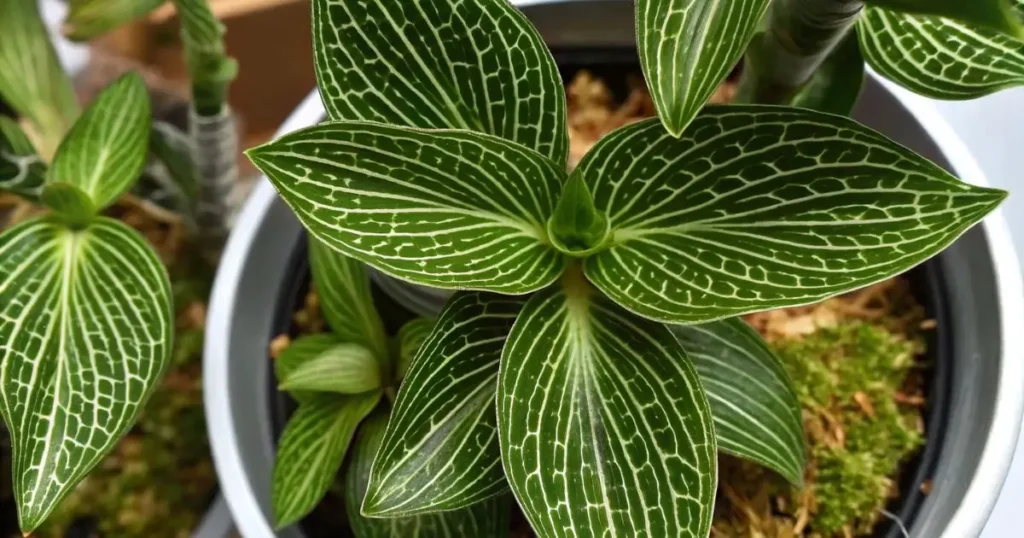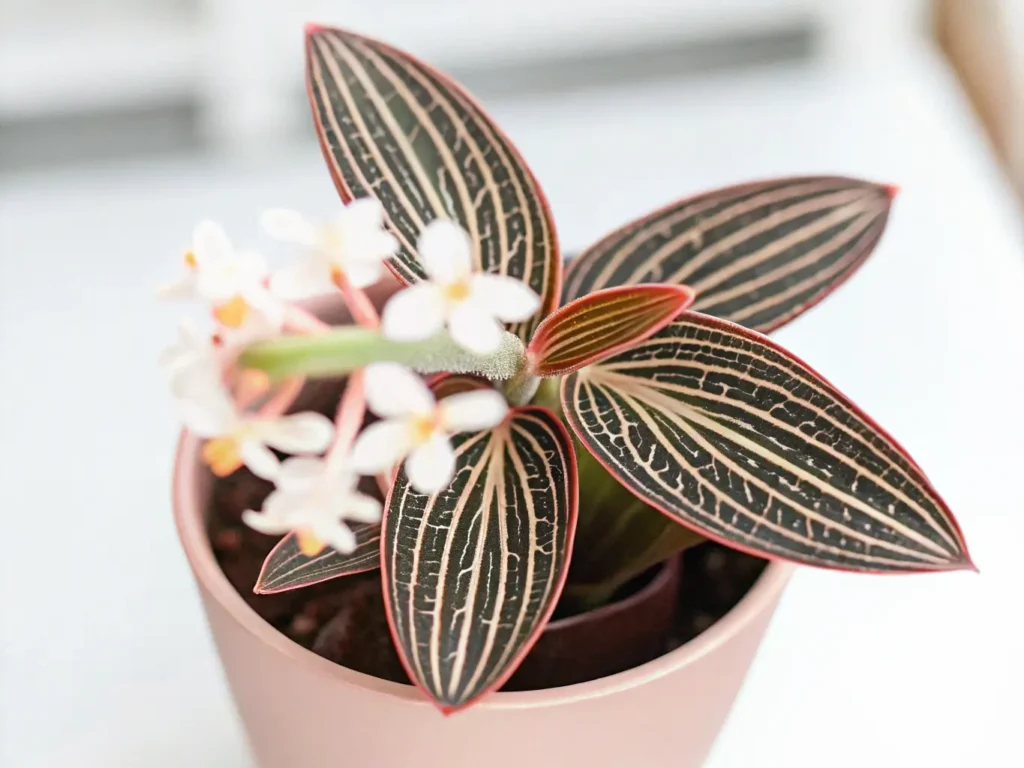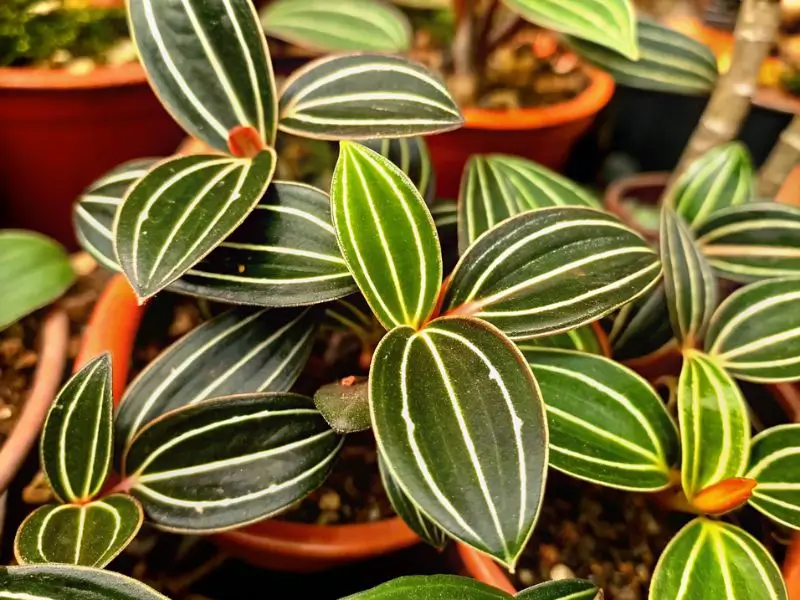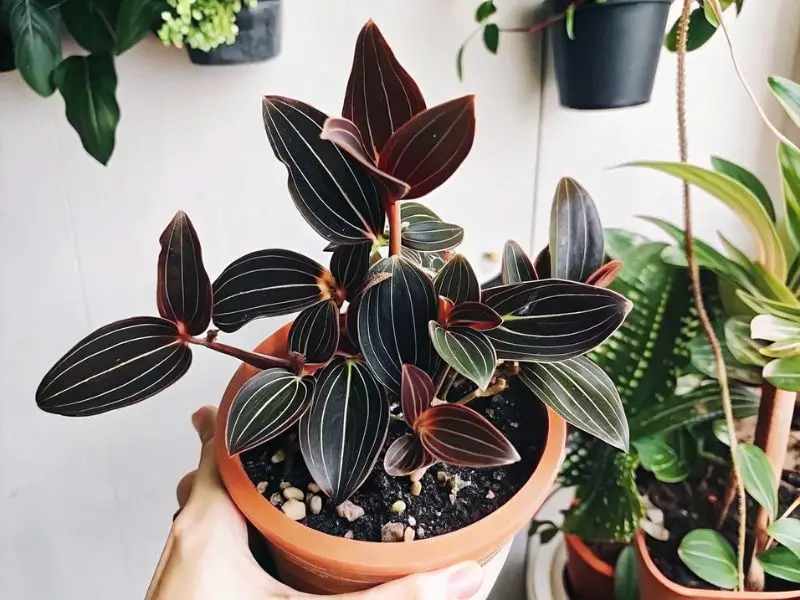
Curious about the jewel orchid, the mesmerizing houseplant with velvety leaves and striking veins? This blog post unpacks everything you need to know about these underrated wonders. With easy pointers on jeweled orchid care, quick tips for propagation, and real-life anecdotes, you’ll discover why orchid ludisia discolor is a can’t-miss addition to any indoor garden, promising continued success improved growth.
Table of Contents
Introduction to the Jewel Orchid
Defining the Jewel Orchid and Its Background
I still recall the day I brought home my first jewel orchid plant. The leaves glistened under the store lights, and I couldn’t resist. A friend in Chicago had mentioned orchid ludisia discolor, which is known for its bold leaf vein patterns rather than giant blooms. Right away, I was hooked.
These jewel orchids stand out among other orchids because they’re terrestrial orchids. Instead of clinging to bark like some varieties, they prefer an earthy potting mix that holds moderate moisture. That’s good news for us, by the way—no fancy greenhouse necessary.
- True orchids with smaller bloom spikes
- Velvety leaves that catch the light
- Often found in tropical undergrowth
In my view, it’s the leaves that make folks do a double-take. While other orchid species are known for big flowers, orchids jewel radiate beauty even without showy petals. So, if you’re up for something different, these might just be your jam.
Distinctive Features of Jewel Orchids
Unique Foliage and Veining Patterns
The first thing I noticed about my black jewel orchid was the dark, almost midnight-like color of the leaves. Golden or pinkish lines run across them, creating a dramatic contrast. Because of this look, I’d say these plants are like living art.
- Velvet leaves with eye-catching veins
- Patterns often sparkle under direct or bright ambient light
- Compact size that adds elegance to small spaces
Honestly, the leaves remind me of lightning streaks trapped in velvet. If you angle a lamp or a desk light just right, the veins can seem to glow. They’ve even earned the nickname “lightning leaves” among some collectors—makes sense, right?
Color Variations Across Different Orchids Jewel
While the classic type is often called orchid ludisia discolor, there are other forms with touches of bronze, maroon, or green. I recently stumbled on a variant that had subtle silver hues when placed under fluorescent bulbs, which was super intriguing. Some folks also gush about Macodes petola, a relative with equally glimmery leaf veins.
Regardless of their color, these jewel orchids share a similar care routine and make excellent houseplants for a cozy home office or an indoor garden corner. That’s part of their universal appeal.
Natural Habitat: Where and How Jewel Orchids Thrive

Native Regions and Climate Requirements
In the wild, jewel orchids usually hang out in the damp forests of Southeast Asia. They nestle on the forest floor, becoming accustomed to low, dappled light and steady moisture levels. Because of this, they adapt pretty well to moderate indoor lighting.
- Thrive in shady or diffused light spots
- Enjoy warmth and consistent humidity
- Prefer a tropical climate with good airflow
If your home is as dry as my place in mid-winter, you might need to add a humidifier or place your black jewel orchid on a tray of pebbles and water. I’ve done that, and it actually helps keep the leaves from curling or looking sad. If your space is naturally humid (hello, Florida folks!), you might have an easier time.
Soil and Moisture Conditions That Suit Jewel Orchids
Unlike epiphytic orchid types, these orchids jewel appreciate a somewhat organic potting mix. I use a blend of peat, perlite, and a dash of fine bark. That way, the mix is airy yet holds enough moisture for these terrestrial orchids.
You’ll want to allow some drying at the top layer before watering again, but not bone-dry conditions. Regular checks help prevent soggy, rotting roots. Trust me—root rot prevention is crucial.
Popular Jewel Orchid Varieties
Ludisia Discolor and Its Subtypes
The most common variety is orchid ludisia discolor. When I started my collection, this was the first species I tried. Its leaves are typically deep green or burgundy with metallic veins.
- Ideal for beginners
- Typically more affordable and easier to find
- Stays compact, about 6-8 inches tall
Certain nurseries might label subtypes differently—some have slightly broader leaves, while others might show more red undertones. Despite the variations, the core traits remain: mesmerizing veins and velvety surfaces that sparkle under a little sunlight or a gentle lamp.
Macodes Petola and Other Rare Jewel Orchids
Macodes Petola is sometimes dubbed a showstopper because it has leaf vein patterns that look like neon lightning under bright lighting. Goodyera species, on the other hand, have subtler lines that mesmerize upon closer inspection.
Though these might be considered rare orchid species, you can sometimes find them in online plant swaps. They each demand similar jeweled orchid care as orchid ludisia discolor, but watch out for their slightly fussier humidity needs. They can be a bit pricy, but that’s part of the thrill for orchid hobbyists.
How to Grow and Propagate Jewel Orchids Successfully
Choosing the Right Medium and Container
When potting a jewel orchid plant, I look for wide, shallow pots with good drainage holes. These roots don’t want to drown. Also, a well-draining orchid potting mix combined with some indoor potting soil (like peat and perlite) works fine. Don’t pack it too tight—you want some air pockets.
- Use shallow containers for stability
- Blend peat with perlite for moisture control
- Consider adding a little fine bark for extra texture
I keep mine on a shelf with moderate light from a north-facing window. They don’t get blasted by direct sun, and they remain warm thanks to indoor heating. This setup has served me well, especially during the cold months.
Propagation Methods: Division and Stem Cuttings
Propagating jewel orchids often involves dividing mature clumps. Carefully separate the rhizomes so each division has a healthy root system and at least one leaf. Then pot each piece in a new container.
Stem cuttings can also work. Snip just below a node, place the cut in water or damp sphagnum moss, and wait for roots to sprout. I’m more partial to division, but it’s exciting to watch cuttings root as well.
Care Tips for Maintaining Healthy Jewel Orchids

Watering, Humidity, and Light Requirements
Although these orchids jewel like moisture, they freak out if left in standing water. I typically water once the top inch of substrate starts to feel more than slightly dry. Adding a humidity tray or a small humidifier nearby works wonders. It’s a trick I learned after one scorching summer dried my home to near desert conditions.
- Water when topsoil is partly dry
- Maintain 50-60% humidity, if possible
- Avoid direct midday sunlight
Soft, dappled light is best. A tinted window or a sheer curtain can protect them. Too much light scorches leaves, leaving them crispy. Too little light can cause long, spindly growth.
Fertilizer and Pruning Best Practices
Once a month, I mix a half-strength balanced houseplant fertilizer and feed my jewel orchid plant. Overdoing it might lead to salt buildup, so I err on the side of caution. When a leaf goes yellow or droops, I prune it off. Quick steps keep fungal and bacterial diseases at bay.
Also, consider rinsing the soil occasionally to flush out excess salts. Just run water through the pot until it drains from the bottom—works like a charm to keep roots happier.
Common Issues and How to Overcome Them
Identifying Pests and Diseases
Often, you’ll find pests like mealybugs or spider mites lurking in leaf junctions. In my case, I spotted a sticky residue on new leaves before noticing the tiny bugs. Quick action with insecticidal soap or neem oil can get rid of them.
- Check for webbing or powdery spots
- Treat early to avoid infestations
- Isolate infected plants if possible
Fungal and bacterial diseases typically show up as brownish or yellowish spots on leaves. Prevent wetting the foliage by watering at the base, which can greatly improve plant health. If you want more tips on controlling pests indoors, check out official USDA guidelines for plant health recommendations.
Troubleshooting Overwatering, Root Rot, and Leaf Discoloration
Overwatering has been my downfall more than once. If you notice squishy stems or nasty smells, you may have root rot. Sometimes you can salvage the plant by cutting off the gooey roots and refreshing the soil.
Leaf discoloration could also result from direct light. If your black jewel orchid is bleaching out, move it to a shadier spot. Conversely, if leaves are drooping, you might need a gentle boost in your watering routine.
Designing Your Indoor Garden with Jewel Orchids

Arranging Jewel Orchids for Maximum Aesthetic Impact
If you want that “wow” factor, place a few jewel orchids together in a terrarium or group them on a tabletop. The varied leaf patterns really pop when displayed side by side. I once lined up three pots of orchid ludisia discolor on my windowsill, and visitors wouldn’t stop touching those velvety leaves.
- Combine different foliage hues
- Use decorative pots or stands
- Position near diffused light sources
Because these plants stay relatively compact, they’re perfect for smaller apartments, window ledges, or shelves. I’ve even seen folks incorporate them into fairy garden setups. They can add a dash of mystique to any room.
Combining Jewel Orchids with Other Houseplants
I love mixing orchids jewel with a variety of easy-care buddies. Nearby, I keep a Snake Plant that stands tall and needs minimal watering. For added bursts of color, I’ve also included a Coleus Black Dragon—it has striking dark leaves that complement the jewel orchid’s velvety textures.
Pairing these plants together helps create a lush, dramatic contrast. Plus, they all enjoy similar indoor temperatures and moderate light, so you can design an indoor jungle that’s both stunning and effortless.
Cultural Significance and Symbolism of Jewel Orchids
Historical Use and Symbolic Meanings
Some folks say that jewel orchids represent hidden beauty. Their blooms might be understated, but their leaves are absolutely stunning. I’ve heard rumors that in certain parts of Asia, people appreciate them as symbols of patience and gentleness.
- Often seen as symbols of quiet elegance
- Some orchid hobbyists consider them good luck charms
- Admired for uniqueness and subtlety
While they may not command the same spotlight as a red rose or a peace lily, jewel orchids certainly capture the fascination of many plant enthusiasts. From my own experience, they bring a gentle, calming quality that subtly reshapes the feel of any living space.
Jewel Orchid Traditions in Different Regions
I’ve spoken with folks who’ve seen local festivals highlight rare orchids—like Macodes Petola—to celebrate nature’s stunning creations. Of course, each area has different customs, and not every region holds an official celebration.
Regardless, these plants often become the talk of the party when guests notice their sparkly veins. It’s like having a natural conversation piece right on your windowsill.
FAQs About Jewel Orchids
Is a Jewel Orchid a Real Orchid?
Absolutely! Even though they’re not known for huge petals, they’re still bona fide orchids—just terrestrial. You might see them listed as orchids jewel, highlighting their shimmering leaves.
Why Are Jewel Orchids So Expensive?
Prices can jump due to slow propagation methods, unique looks, and collector demand. A more unusual variety like the black jewel orchid can fetch a higher tag. It seems folks are willing to pay more for something that stands out in their home garden.
Are Jewel Orchids Easy to Care For?
Yes! In most cases, jeweled orchid care comes down to consistent humidity, moderate watering, and gentle light. They’re kind of perfect for folks who want a fancy-looking plant without a complicated routine.
Are Jewel Orchids Rare?
Some species, like Macodes Petola or certain Goodyera species, can be called “rare.” However, orchid ludisia discolor is pretty common in specialty nurseries and online. If you stay patient and keep your eyes peeled, you’ll likely find one that fits your preferences.
Bonus Tips & Conclusion

Before I wrap this up, here are a few pointers I’ve learned along the way:
- Water thoroughly, but don’t soak roots for days
- Keep humidity levels stable with a small humidifier
- Check leaves often for pests or spots
- Trim dead foliage to maintain a tidy appearance
From their enchanting leaf vein patterns to the easy-peasy maintenance routine, jewel orchids bring a unique charm to indoor spaces. I’ve had mine on display during holiday gatherings, and friends often ask, “What’s that sparkly-leaf plant?” I love telling them that these are the legendary orchid ludisia discolor, also known as the black jewel orchid, which belong to the “bewitching foliage gang.”
Whether you’re a total newbie or a seasoned plant fanatic, there’s room in your home for a jewel orchid. If you crave striking foliage without the drama of high maintenance, this plant could be your perfect match. Hopefully, these tips boost your confidence in tending to jeweled orchid care. Go spread some leafy magic, everyone!

1 thought on “Jewel Orchid: Complete Guide for Indoor Plant Lovers”
Comments are closed.